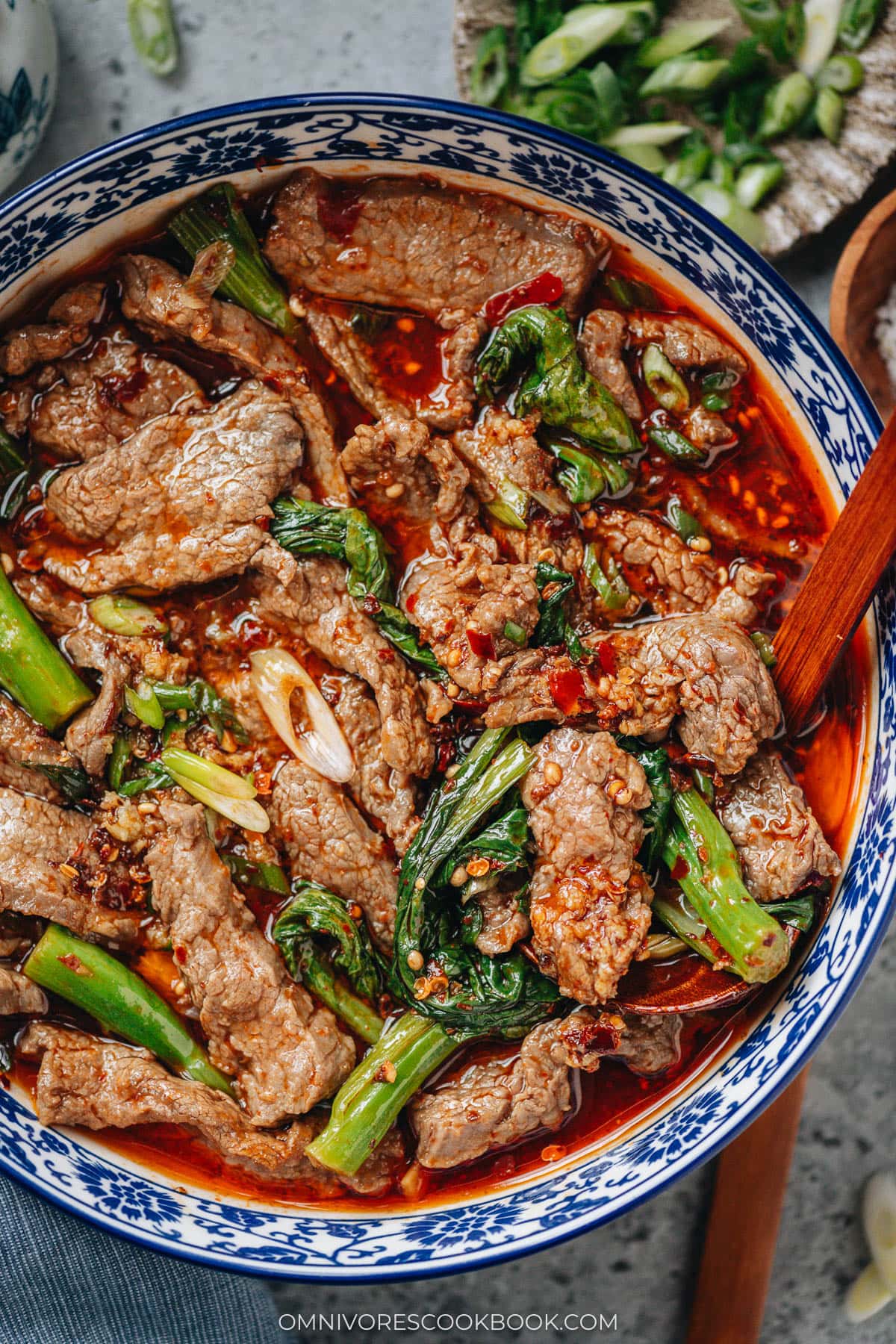
Sichuan boiled beef is a sister dish of Shui Zhu Yu, or Sichuan boiled fish. In China, it’s a very popular dish in Sichuan restaurants. The dish is made with beef slices that are marinated until flavorful and tenderized, then poached in a hot spicy broth until silky and juicy. Vegetables such as bean sprouts, Chinese broccoli and napa cabbage are often used as an accompaniment in the broth to add texture. The dish is then finished up by drizzling hot oil over spices and aromatics. So every bite of beef is coated with a thin layer of the numbing spicy oil, making it so addictively delicious.
Fun Fact
If you order this dish at a Sichuan restaurant, you’ll get a giant bowl of Sichuan boiled beef with countless chili peppers floating on top. You’ll have to fish through the bowl with a strainer to discover the pieces of goodies underneath the oil. And of course you’ll usually come up with one piece of beef, five peppers, and ten peppercorns with one scoop of the strainer. When it comes to the homemade version, we’re skipping some of the presentation. But the flavor of the dish remains the same!
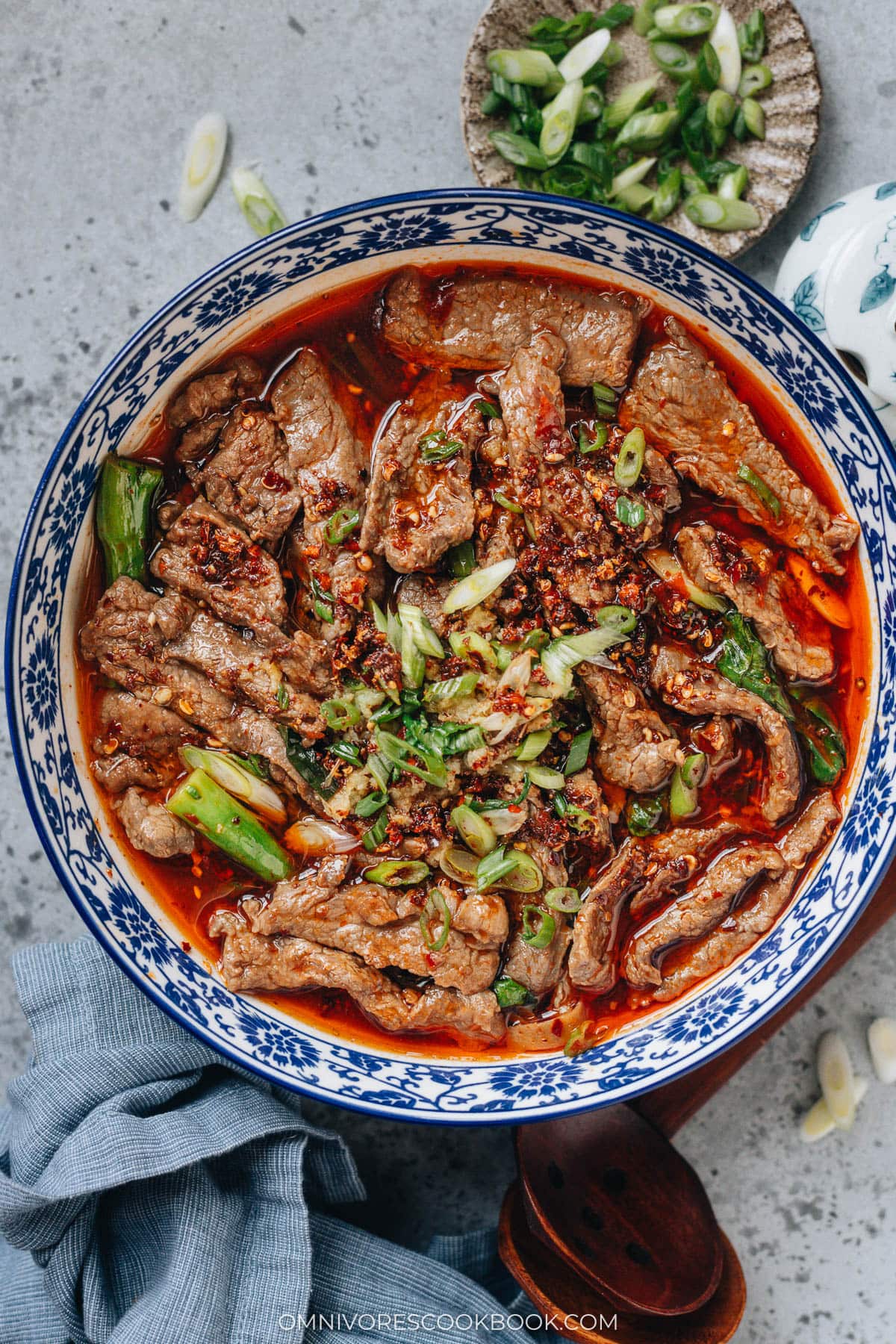
Sichuan boiled beef ingredients
The key to making the best Sichuan boiled beef is the broth and the spice topping.
The broth base
- Chicken stock: A good chicken stock helps a lot. I like the organic chicken stock from Costco.
- Doubanjiang: the key ingredient for the flavor of the broth. Check out my pantry article on more details of this ingredient and how to source it.
- Garlic
- Ginger
- Scallion
- Shaoxing wine
- Sugar: An important ingredient to counterbalance the saltiness and spiciness of the dish, bringing out the flavor of the ingredient.
- Soy sauce
- Chicken bouillon: chicken bouillon or a touch of MSG goes a long way.
Spice topping
- Dried chili pepper: Chinese dried chili peppers work the best for a good balance of heat and fragrance. If not available, Korean dried chili peppers are a good alternative.
- Sichuan peppercorns: The key ingredient and it adds fragrance and the numbing sensation to the dish. Check out my pantry page on this ingredient and how to source it.
- Garlic
- Scallion
Mise en place
When you’re ready to cook, your table should have:
- The broth base ingredients (listed above)
- The spice topping ingredients (listed above)
- Marinated beef
- Chinese broccoli (or your choice of greens), washed and chopped
- Cornstarch slurry
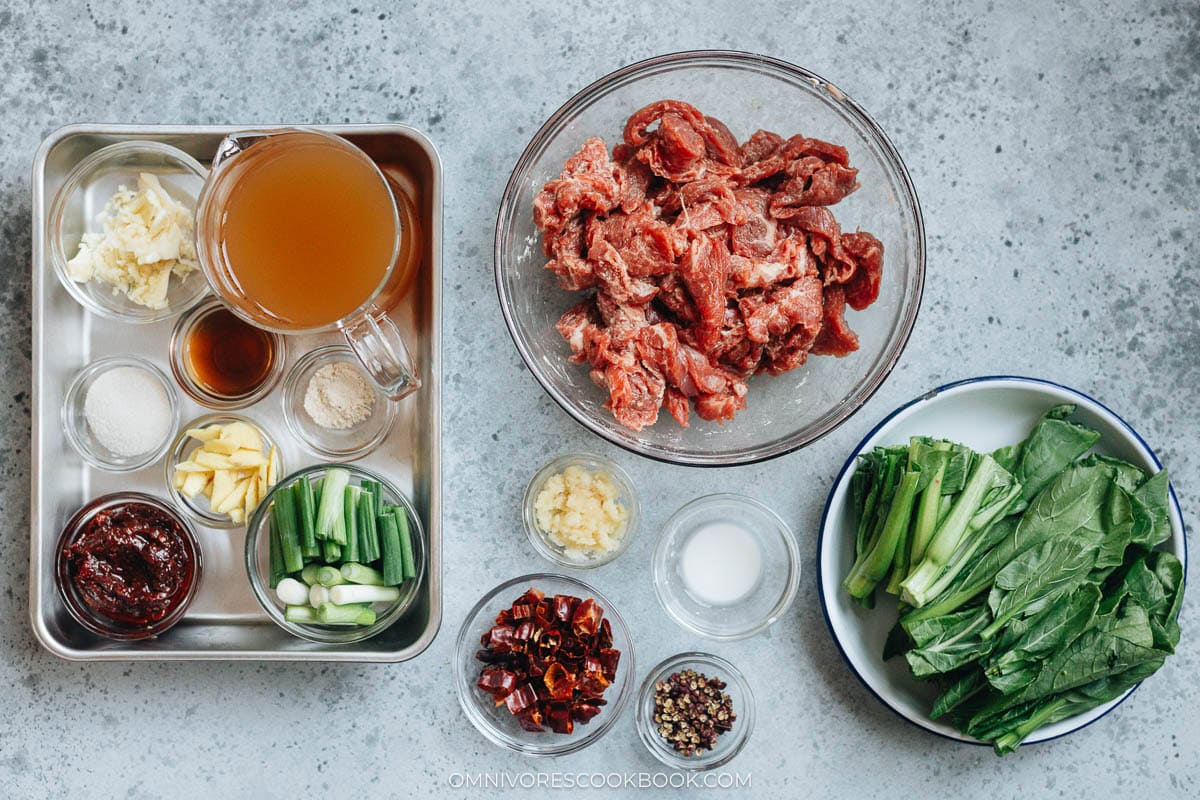
How to cook Sichuan boiled beef
Fry the spices and make the spice topping: Cook the dried chili peppers and Sichuan peppercorn in hot oil until they have darkened and become fragrant, but not burned. Transfer the spices into a small grinder and blend them into powder.
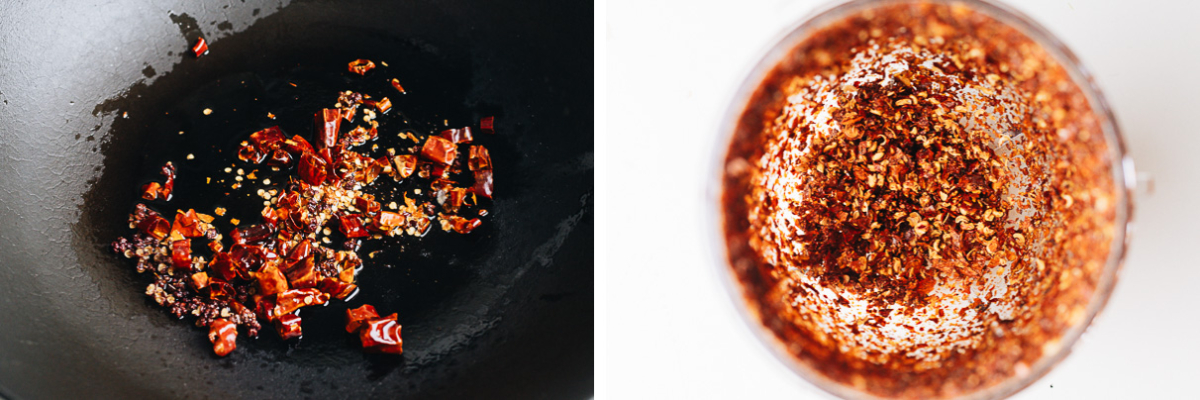
Cook the ginger, garlic, scallion and doubanjiang until very fragrant.
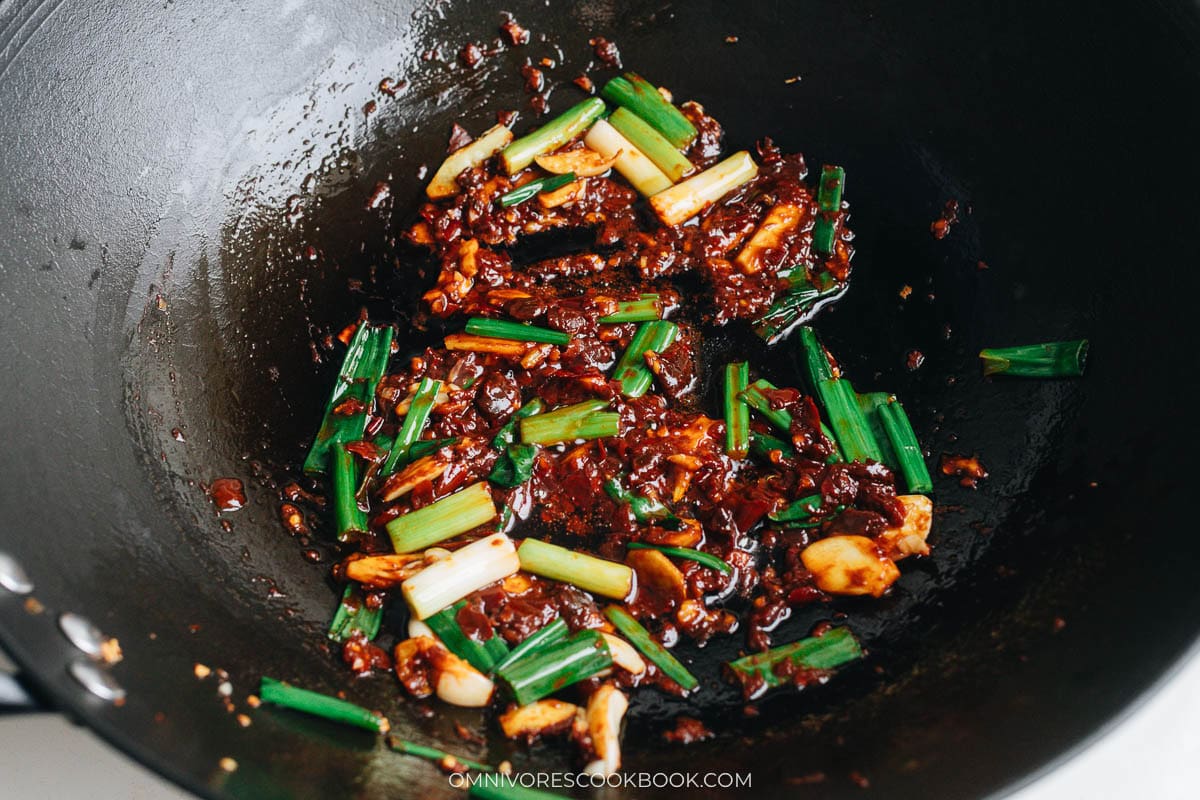
Deglaze the pan with Shaoxing wine. Then cook with the chicken stock until boiling. Remove and discard the solid ingredients.
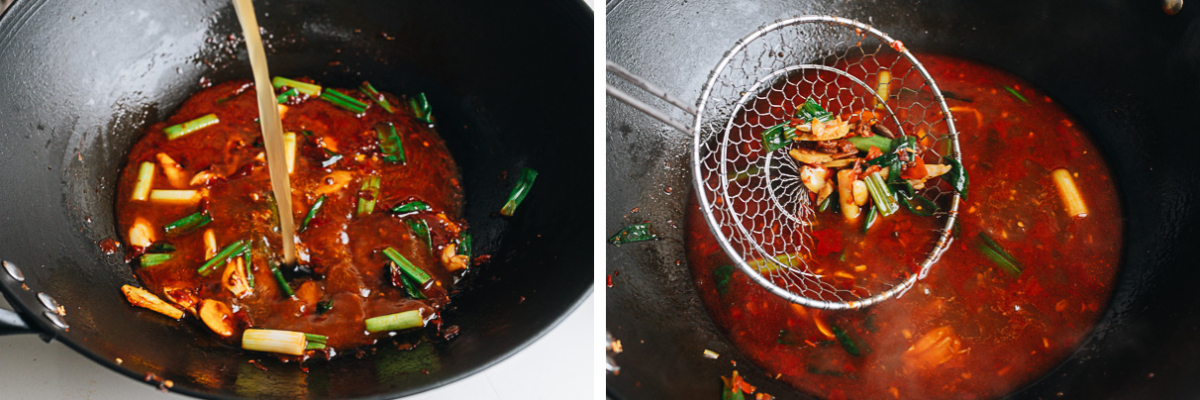
Cook the Chinese broccoli and beef slices separately, transferring both to a prepared large bowl. To get the best beef texture, it’s important to gently poach the slices until just cooked through. I prefer to cook until the beef is still slightly pink on the inside. When the beef is sitting in the hot broth, the broth will slowly cook the beef through with its residual heat.
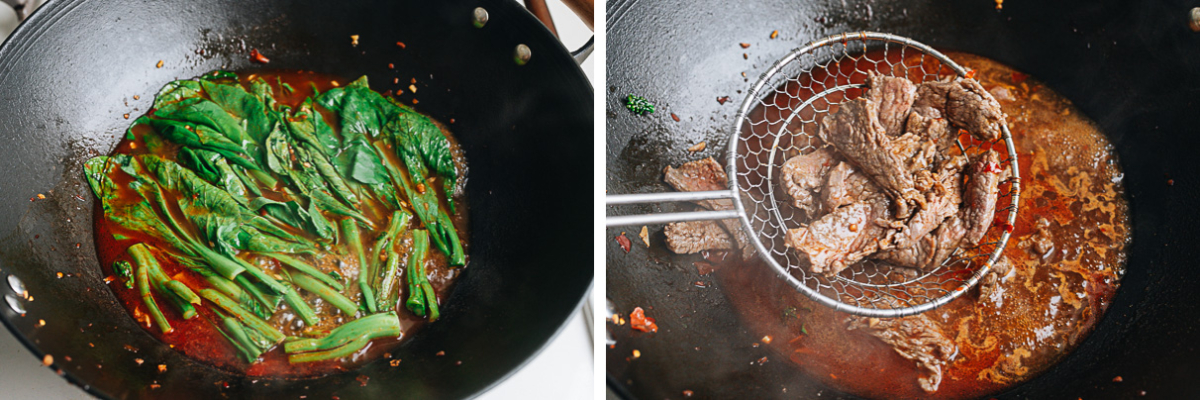
Pour the broth into the big bowl to mostly cover the beef, top with the ground spices, garlic and extra scallion. Then heat up some hot oil to drizzle over the aromatics.
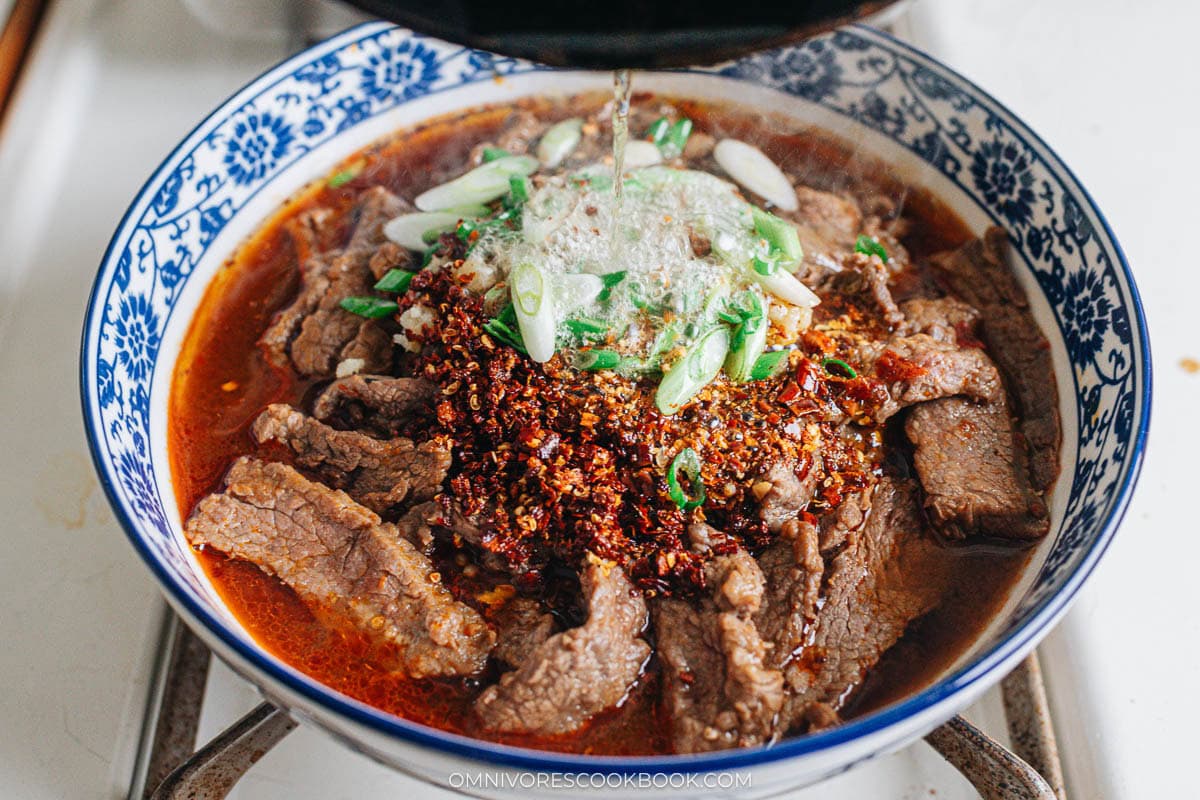
Do I need a wok?
You don’t need a wok to cook Sichuan boiled beef. I used a wok in this recipe because I like the shape of a wok for this specific dish. But you can easily use a medium-sized pot or dutch oven instead of a wok.
Important Cooking Tips
The hot oil is a very important part of the recipe and do not skimp on the oil.
To finish the dish, you will add a layer of raw garlic and scallion, plus the ground up Sichuan pepper and chili pepper on top of the beef. By drizzling plenty of hot oil onto this mixture, you are cooking the raw aromatics to make a super fragrant aromatic oil.
The finished dish will be covered with a layer of oil. So, when you pick up a piece of beef or vegetable, it will be coated with the numbingly spicy broth and nutty garlicky oil. It makes things perfect.
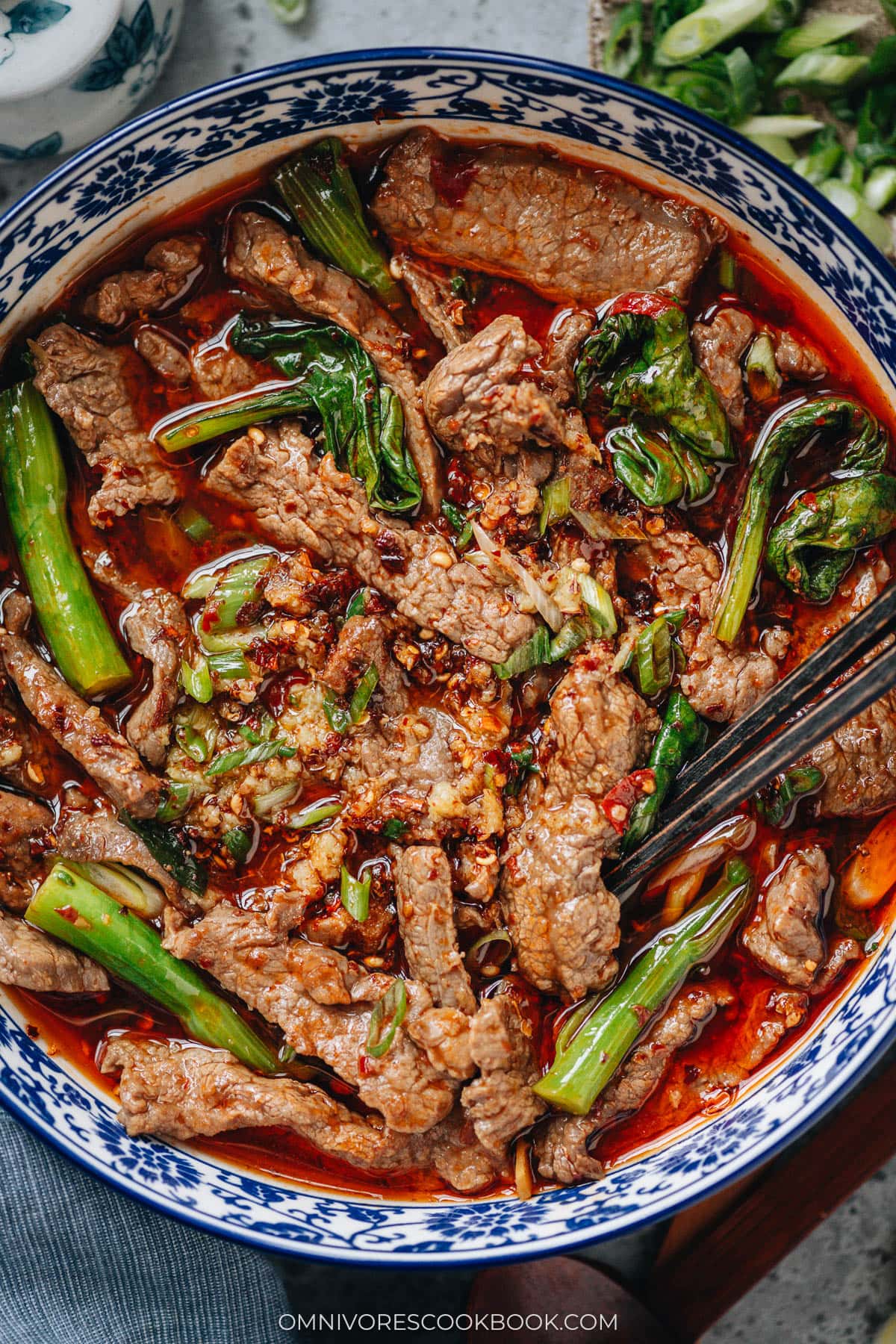
How to serve Sichuan boiled beef
Serve the Sichuan boiled beef piping hot as a main dish. It’s best to accompany it with steamed rice.
Stir the topped aromatics to mix into the hot broth. Then use a slotted spoon to serve the beef and vegetables.
To make a full-on Sichuan dinner, consider serving these dishes along with the Sichuan boiled beef:
- Dan Dan Noodles or Sesame Noodles
- Stir Fried Pea Shoots
- Red Oil Chicken (Mouthwatering Chicken)
- Cucumber Salad
- Sichuan Dried Fried Green Beans
- Eggplant in Garlic Sauce (Yu Xiang Eggplant)
Chinese Cooking Made Easy
Are you new to this website? This free email series is a great place to start. I’ll walk you through a few of my most popular recipes and show you how and why they work. You’ll quickly start to cook better Chinese food in your own kitchen.
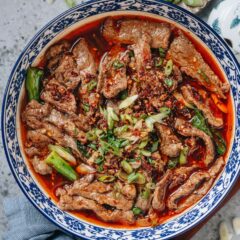
Sichuan Boiled Beef (水煮牛肉)
Ingredients
Beef marinade
- 1 lb beef flank steak
- 1 tablespoon Shaoxing wine
- 2 teaspoons soy sauce
- 1/2 teaspoon salt
- 1/4 teaspoon white pepper
- 1 tablespoon cornstarch
Topping
- 1/3 cup + 2 tablespoons canola oil , divided (or other neutral oil)
- 1/2 cup Chinese dried chili peppers , halved (seeds removed for a less spicy dish)
- 1 tablespoon Sichuan peppercorns
- 6 cloves garlic , grated
- 1 scallion , sliced
Soup base
- 4 cloves garlic , smashed
- 1 " ginger , sliced
- 3 scallions , cut into 1" (2.5 cm) pieces
- 3 tablespoons Doubanjiang
- 1 tablespoon Shaoxing wine (or dry sherry)
- 2 cups chicken stock
- 1 tablespoon sugar
- 1 teaspoon soy sauce
- 1/2 teaspoon chicken bouillon (or to taste) (Optional)
- 6 to 8 heads Chinese broccoli , sliced to large bite-size pieces (or bok choy, yu choy, or other vegetables you prefer)
Slurry
- 1/2 teaspoon cornstarch
- 1 teaspoon water
Instructions
Prepare the beef
- Cut the beef flank steak along the grain into two pieces. Then slice against the grain by tilting your knife to 45° and slicing the beef into 1/4″ (1/2 cm) thick pieces. Transfer to a medium-sized bowl.
- Add the marinade ingredients except the cornstarch. Gently use your hand to mix the beef until the ingredients are absorbed. Then add the cornstarch and mix again until the beef is evenly coated. Set aside to marinate for 15 minutes while preparing the rest of the ingredients.
Prepare the topping spices
- Heat a medium-sized wok over medium heat with 2 tablespoons of oil until hot. Add the dried chilis and Sichuan peppercorns, turn to medium-low heat. Cook and stir until fragrant and darker, about 2 minutes. Transfer the spices to a plate to cool slightly, reserving the oil in the pan. Turn off the heat.
- Add the fried spices into a small food processor or blender. Pulse until coarsely chopped. Set aside.
Prepare the soup base
- Reheat the same wok over medium heat until hot. Add the garlic, ginger, and scallions. Cook and stir until fragrant, 1 minute or so.
- Add the doubanjiang. Stir for another 2 to 3 minutes. Turn to low heat if the paste starts to stick to the pan too much. You can also pour a bit of water into the pan to release the paste.
- Pour in the Shaoxing wine and use a spatula to lift as much of the brown bits from the bottom as possible. Add the chicken stock and keep scraping the bottom.
- Add the sugar and soy sauce. Cook over medium-high heat until brought to a boil. Reduce to a simmer and cook for 2 to 3 minutes. Use a mesh strainer to remove the solid spices and discard them. Taste the broth. It should be slightly salty by itself. Add chicken bouillon to adjust flavor if needed.
Finish up
- Prepare a large heat-proof bowl, enough to hold most of the broth, the vegetables, and the beef. (*Footnote 1)
- Add the Chinese broccoli to the broth and blanch until cooked to your desired texture, about 2 minutes. Remove it from the broth and place it on the bottom of the big bowl.
- Bring the broth back to a simmer. Cook the beef slices in two batches if needed so they don’t crowd the pan. Add the beef and immediately use a pair of chopsticks or tongs to stir and separate the pieces. Poach for a minute, or until the beef is just cooked through. Transfer the beef into the big serving bowl, on top of the Chinese broccoli.
- Bring the broth to a boil again. Stir to fully dissolve the cornstarch slurry and pour it into the broth, stirring constantly. Cook for 1 minute, until the broth is slightly thickened. Then pour the broth into the serving bowl, until the beef slices are mostly covered. Set aside the remaining broth if there is any left. (*Footnote 1)
- Spread the prepared topping spices – the fried and ground up chili peppers and Sichuan peppercorn, over the broth. Spread out the sliced scallions and the grated garlic.
- Heat the remaining 1/4 cup oil over medium heat in a small pot or saucepan until just smoking. Carefully drizzle the spices over the serving dish. The oil will spatter a bit but shouldn’t cause a mess. Serve hot as a main dish.
Notes
- You can save the broth to cook with it again. Meat slices, vegetables and tofu all taste great cooked in it.
Nutrition

Did you make this recipe?
I’d love to hear how it turned out for you! Please take a moment to leave a 5-star rating ⭐️ and share your thoughts in the comments further down the page. It really helps others discover the recipe too.

Dan
Typo in instructions:
Prepare the “fish” fillets -> Prepare the beef
Maggie Zhu
Oops! Thanks for letting me know. Just fixed it.
AliceK
This was excellent! But, Maggie, I have to tell you, we are not Sichuan. My husband can’t eat very spicy things. I reduced the doubanjiang to one tablespoon, and the chilis in the spice mixture to only about 5 chilis, deseeded. But it was still very good. I used bok choy as the green vegetable.
LucieM
I’ve made this recipe numerous times & it’s like I’ve had authentic Chinese delivery. So delicious! Thank you!
Pete
This is fantastic, my new favourite. I had trouble tracking it down as I was looking for “Boiled Beef.” Anyway, got there in the end and loved it. Will definitely be making it again.
Lucie Marcq
I was sceptical at the thought of boiling beef but the cornstarch made it into a thick sauce & pieces were not in for long. I loved this recipe! It was delicious – a total keeper! Thank you!
Marija
“The numbingly spicy silky beef is so addictively delicious that you cannot stop eating” – absolutely true. We literally couldn’t stop eating, the two of us polished this off in one sitting. The beef was silky and soft, and the spices just right… Fail-safe recipe, as far as I’m concerned.
Nancy | Plus Ate Six
My mouth is watering just reading though the recipe – Szechuan is one of our favourite cuisines and I love the numbing chilli sauce.
Maggie
This is one of my favorite Szechuan recipes! I wish more people can try this out. Most people here never heard of this. Me too, love the numbing chili sauce 🙂
Marion
Hi, I am looking forward to trying out this wonderful-sounding and looking recipe here, but have trouble finding the ingredients (without ordering them online). I found the following an am curious if I could use that instead of your recommended spicy fermented bean paste (doubanjiang):
Oriental Wok Gourmet Asian Sauces: Sichuan Chili Spicy MaLa Sauce. The ingredients listed on back are: Soybean Oil, garlic, ground bean sauce, soy sauce, red pepper, sugar, salt, spices, Sichuan peppercorns.
Please let me know. Thank you so much! I cannot wait to try this meal.
Have a great day,
Marion
Maggie
Hi Marion, the ingredients of the Sichuan mala sauce sounds about right. I never tried the brand, so I’m not sure you can replace doubanjiang with it. If the sauce is the authentic type, it should be quite thick (some of them are close to paste), rich and spicy. In this case, you should able to use it to replace chili pepper and doubanjiang. You can still follow the recipe by adding green onion, garlic and Sichuan peppercorn (maybe reduce the amount of peppercorn, depend on the flavor of the sauce). You might also need to add more mala sauce than 3 tablespoons, because you want a very flavorful broth. It’s very difficult for me to determine how much sauce you should add. But you can always add more after tasting the broth. The broth should be quite salty, spicy and have a nutty numbing flavor (It’s not for drinking).
I hope this is helpful. And let me know how the dish turns out 🙂
Ange @ Little Kitchen Blue
Oh delish. One to try for sure…thank you
Mira
This dish is bursting with flavor and I love it! Great pictures Maggie! Need to make some poached beef!
Rachael
Can you substitute the chili garlic sauce in this recipe? Most of the ingredients are similar, and I keep it on hand.
Maggie
Hi Rachael, you posted a very interesting question! It never occurred to me to use the chili garlic sauce in this recipe. I haven’t tried it yet, but I think it should work.
My only concern is, the chili garlic sauce is quite spicy, because you broke the chili pepper apart. The poached beef dish is not THAT spicy, and it emphasize the numbing spiciness that is generated from the peppercorns. So you can try this:
Add the chili garlic sauce (you need a lot, as long as you can handle the spiciness), soy sauce, rice wine and a bit more spicy fermented bean paste. Stir fry to bring it to a simmer. Add water and follow this recipe. For step 17 (very important), besides spreading garlic and green onion on top, you should also add grounded Szechuan peppercorn (1/2 to 1 teaspoon). So the hot oil will be infused with more numbing spicy flavor. I think you should able to create something very similar by using this method.
Let me know how the dish turns out if you decided to try it out! Happy cooking 🙂
Kevin | keviniscooking
The poached aspect intrigue me and I had to read further and then you said the “numbing spiciness…” THEN said, “It is the fried-bacon-in-bacon-fat kind of good. I was sold! Going to try this one.
Once when we were in a Thai restaurant over in Hawaii it was served in a bowl and there must have been a 1/4 inch of floating red pepper flakes on top. It was INSANE and actually ruined the rest of the meal for us, but you know me, I’m up of this one. 🙂
Maggie
I’m so glad to hear you are interested at this dish Kevin! It definitely belongs to hardcore Chinese dish, and I think the people who decided to cook it must have tried the real one in China. And by the way, if you order it in China, it will come with 1/4 inch of floating red pepper on top (the flakes sounds insane though!).
As long as you use mild dried whole chili pepper (don’t break them apart!), this recipe shouldn’t turn up too spicy. It emphasizes more on the numbing spicy flavor from the Szechuan peppercorn. Anyhow, let me know how the cooking turns out 🙂